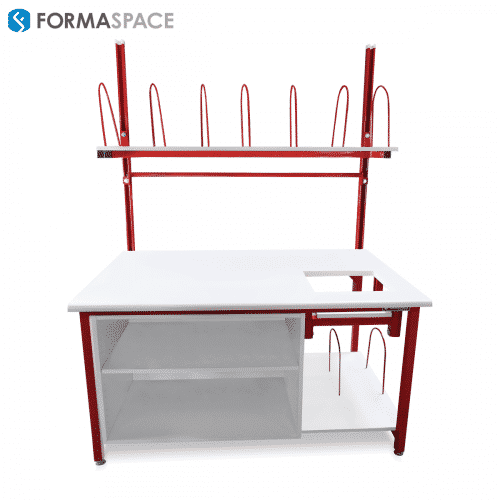How can we work to improve material handling in the workplace?
Let’s take a look at three interdependent aspects of a well-managed material handling operation: Worker Safety, Ergonomic Considerations, Quality and Efficiency
The Need to Create a Safer Material Handling Workplace
Since 1970, the Federal Occupational Safety and Health Administration, better known as OSHA, has been charged with making work environments safer, and conditions have improved overall.
Where does material handling fit into the picture? According to the Bureau of Labor Statistics, in 2014 non-fatal occupational injuries and illnesses in the Warehousing and Storage sector (NAICS code 493) were relatively high, with 5.2 cases per 100 workers. Of these, 1.7 workers had to take days off, and 1.9 employees had to transfer to another job category or work with restrictions.
Again, these statistics are for standalone warehousing and storage operations — since material handling is part of manufacturing and other industries, we should look at some other major industry categories for a comparison:
Industry Category |
Total Incidents,
|
Incidents w/days off,
|
Incidents w/job transfers or restrictions,
|
| Wood Products, subset of manufacturing | 6.8 | 1.9 | 1.8 |
| Warehousing and Storage, all categories | 5.2 | 1.7 | 1.9 |
| Food Manufacturing, subset of manufacturing | 5.1 | 1.3 | 2.0 |
| Manufacturing, all categories | 4.0 | 1.0 | 1.2 |
| Construction, all categories | 3.6 | 1.3 | 0.6 |
| Mining, incl Oil/Gas, subset of manufacturing | 2.0 | 0.8 | 0.4 |
| Source: Employer Reported Workplace Injuries and Illnesses 2014, Bureau of Labor Statistics, U.S. Department of Labor |
|||
As it turns out Warehousing and Storage occupations are quite dangerous, more dangerous than all manufacturing jobs with the exception of Wood Product Manufacturing, and more dangerous than construction and mining jobs, including oil and gas extraction.
After looking at these statistics, we’re left with more questions than answers. For example, why do standalone warehousing and storage operations have more accidents compared to other, similar industries? Is this representative of material handling safety overall or not?
If we had more workplace safety data, we could drill down into the statistics for comparable industries (like food and beverage manufacturing) to see if material handling is responsible for a disproportionate number of accidents within these industries as well.
However, there may be another way to assess material handling safety in the workplace — by taking a look at the leading causes of injuries that result in disability claims.
According to Liberty Mutual’s 2016 Workplace Safety Index, these are the Top 10 accidents responsible for disability claims — to the tune of $50 billion dollars:
- Overexertion involving an outside source (NOTE: this item alone represents 25% of the total!)
- Falls on the same level
- Falls to lower level
- Struck by object or equipment
- Other exertions or bodily reactions
- Roadway incidents involving motorized land vehicle
- Repetitive motions involving micro-tasks
- Struck by object or equipment
- Caught in/compressed by equipment or objects
- Slip or trip without fall
Just scanning this list, it’s clear that any one of these accidents could very easily happen during material handling operations. This would help explain why the safety record of the Warehousing and Storage category fares so poorly in the BLS worker injury statistics above.
Improving Material Handling Quality and Efficiency Can Improve Safety Culture at the Same Time
Look at the list of Liberty Mutual’s Top 10 disabling workplace accidents again — then take a moment and visualize your material handling operation.
- What if you could design your facility so that it had a more efficient layout, so materials flowed in a logical path with the fewest possible steps?
- What if you were able to reduce the number of material transfers in and out of storage by half?
- What if you segregated forklift operations completely away from foot traffic?
- What if your storage racks and conveyors were more secure and also incorporated safety features that helped prevent accidents, like materials falling on workers?
- What if you used mechanical assist lifts throughout your facility that prevented workers overexerting themselves by lifting heavy objects?

Get an Outside Perspective on Your Material Handling Operations
Sometimes it helps to have fresh eyes look at an existing problem. As you probably know already, Formaspace does more than manufacture work benches, laboratory tables, material handling and packing stations; we also provide 5S and Lean Manufacturing consulting to industry clients who are looking to improve the efficiency of their operations.
Our Rapid Plant Assessment can help.
It’s based on research by Professor R. Eugene Goodson from the University of Michigan as well as work by Hiroyuki Hirano, famed consultant to Toyota, and industrial efficiency expert Robert B. Pojasek.
Goodson’s approach allows us to undertake a thorough assessment of an industrial facility in just a few hours’ time, while Hirano’s research, which led to the 5S approach promoted by Pojasek, helps uncover production inefficiencies by asking a series of “why?” questions.
For material handling operations, we often uncover the following issues during an onsite Rapid Plant Assessment:
- Many workplaces are congested and poorly organized with choke points where material handling accidents can occur. Creating clean, wide open spaces with everything in its designated space (a key component of a 5S program) contributes to a safer, more productive workplace.
- Material inventory that is rarely used is often stored in inappropriate locations. Moving these materials to long-term storage can either recover valuable floor space or make room for materials that are used more often, thereby increasing efficiency and shortening transfer distances. Formaspace can design storage solutions to help you recover floor space by increasing the density of your storage, which can then help reduce your overall real estate costs.
- If tools and equipment are not in good condition, this is a sign that management and workers are not committed to making continuous improvements. We also look for evidence of timetables posted with preventative maintenance programs.
- Work in Process materials generally should be stored at the side of the production line — not too much, not too little. Working processes should follow a continuous logical flow, following the fewest amount of steps needed. If this is not the case, it not only reduces efficiency, and it can increase the statistical chance of accidents by increasing the amount of material handling required.
- To increase safety, the transfer of heavier awkward items should be automated or done using a mechanical assist. However, using mechanical assistance doesn’t mean using forklifts by default; oftentimes manual pallet jacks are safer to use when transporting objects over short distances. Pallet jacks are cleaner and quieter (which allows for better worker communication), and, since they raise objects only a few inches off the ground, they reduce the chance of accidents caused by objects falling off of pallets hauled by forklifts.
Don’t Overlook Ergonomic Design Considerations in Material Handling Operations
Returning to the Liberty Mutual Top 10 list of disabling workplace injuries above, exertion shows up on the list twice:
Over exertion involving an outside source is number one on the list, responsible for one-quarter of all disabling workplace injuries. #5 on the list is related to this: Other exertions or bodily reactions.
What do these statistics mean for manual material handling?
The short answer is it’s critical to limit the amount of lifting, reaching and bending movements required from workers.
In the case of handling materials, excessive lifting, reaching and bending needs to be designed out of the system — either by creating natural material workflows where objects are always handled at a safe height — or by incorporating mechanical lifts, elevators and other devices (such as robotic assist).
Another consideration is that not all workers are alike. We’re all pretty comfortable with the idea of adjustable seats — but that’s not sufficient in most cases. Work surface heights need to be fully adjustable as well to accommodate short and tall workers.
Workers Need To Move More, Sit Less during the Day
Research shows that height adjustable work surfaces that accommodate differently sized individuals have additional health benefits.
Reducing the number of “sitting hours” for workers on the job improves their circulation and helps reduce lower back pain injuries.
Formaspace creates a complete line of Sit-to-Stand work tables, material transfer stations, and packing tables that can be height-adjusted at the touch of a button.
Create an Ergonometric Action Plan for Your Workers
Considering that overexertion is the number one cause of accidents that result in disability claims, it’s important to create an ergonometric action plan to help protect your employees from injury when manually transporting heavy items.
Find easier ways for employees to move, raise, lower, fill or empty awkward and bulky containers.
- Consider dividing heavy loads into smaller containers that are easier to handle
- Containers need to have adequate handles, grips or handholds.
- Ensure employees maintain a proper hand grip when lifting objects.
- If employees are wearing gloves, they should be well-fitted. Rubber dots on the palms and finger pads can improve grip.
- Well-fitted, non-slip footwear helps prevent accidental slips and falls.
- Train employees to hold heavy loads close to the body.
- Employees carrying heavy loads need to either take necessary rest breaks or alternate their assignments with less physically demanding tasks.
Find easier ways for employees to transport containers manually.
- If employees carry containers over their shoulder, they could use a shoulder pad for cushion.
- Custom tools can help lift awkward objects, like potted plant containers.
- When carrying buckets or pails, increase the handle diameter to 1.25” to 2” inches using padding around the handle or a temporary clip-on tool; this will improve grip strength and reduce hand fatigue.
- Use mechanical devices to raise or lower containers and other heavy objects to an appropriate height for each employee.
- Use custom tools like hooks to extend your reach.
Implement alternative methods for transporting heavy containers that don’t rely on employees to carry them by hand.
- Avoid pouring liquids from heavy containers; instead use a siphon or pump to transfer liquids to smaller containers.
- Use non-motorized mechanical tools like floor jacks or drum dollies that allow employees to move heavy objects without having to lift heavy weights.
- Transfer heavy objects to low-center-of-gravity push carts. Pushing is statistically safer than pulling carts.
- Use push carts with built-in scissors lifts to raise heavy objects to table height or lower them for transport.
- Use heavy-duty, well-balanced hand trucks to move boxes, bottles, and cylinders.
- Avoid lifting entirely by creating conveyor systems to move heavy objects. Skate wheel and roller conveyors, slides, and chutes can operate by gravity alone.
- For heavy objects, consider using a portable hoist (cherry picker) or gantry crane.
Formaspace Is Your Partner for Safer, More Efficient Material Handling Operations.
Want to know more? We’d love to give you more information about the benefits of conducting a Rapid Plant Assessment at your facility.

Contact your Formaspace Design Consultant today. We can help make your material handling operations more efficient and safer at the same time.











